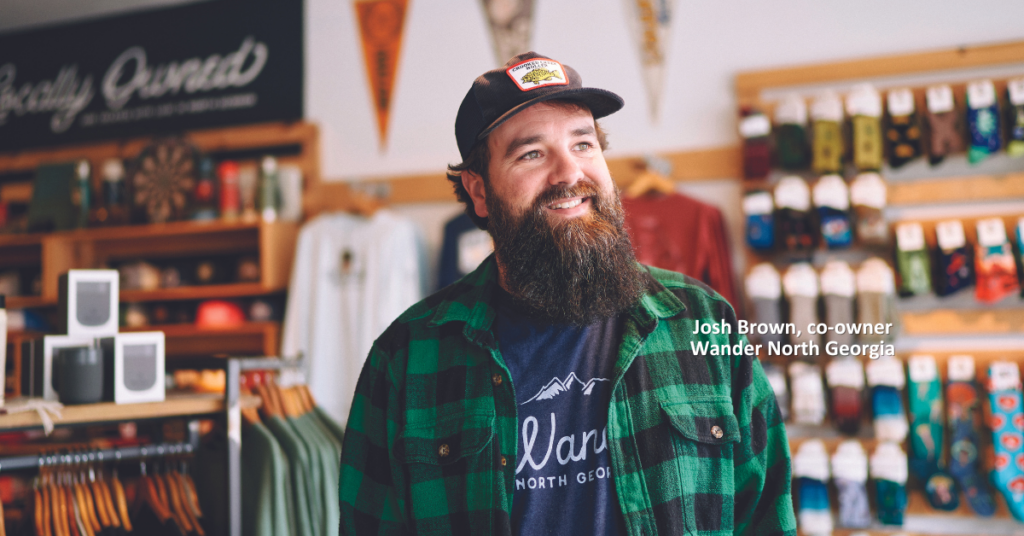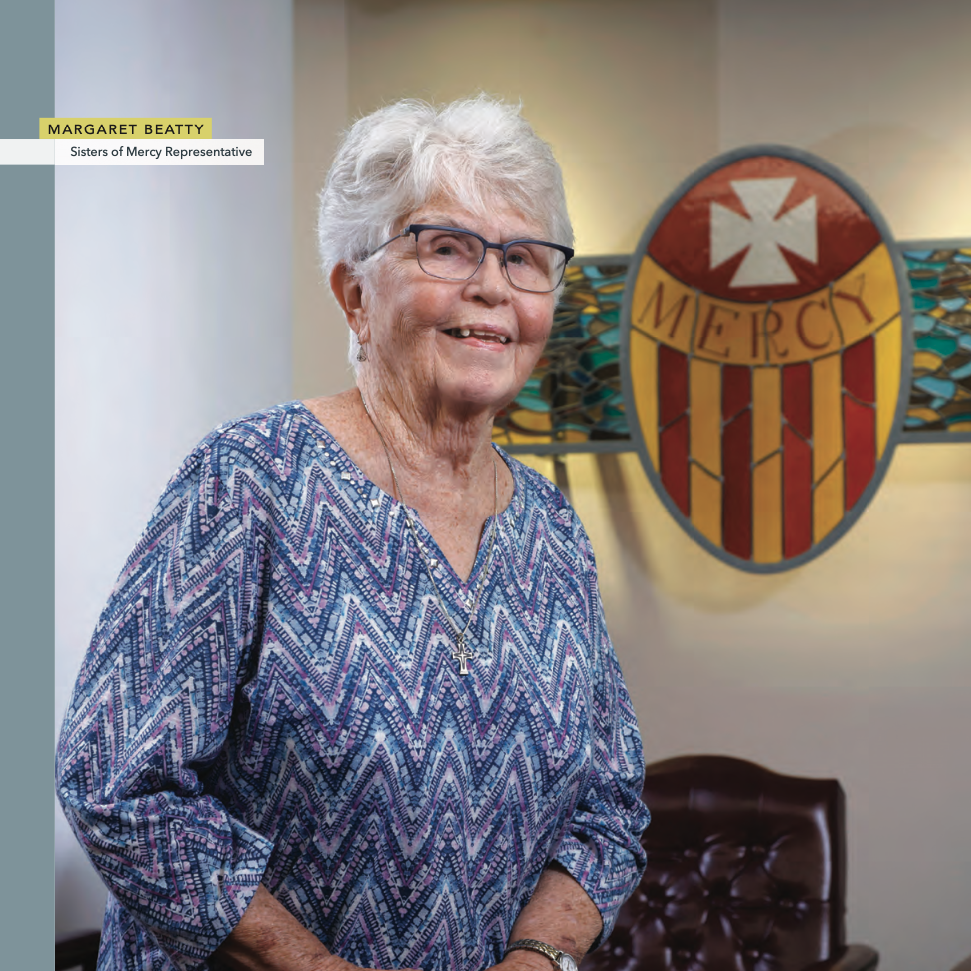Lending for Life
Community banks provide high-tech, high-touch service to their customers, while investing in the communities they serve.
At a time when financial transactions are frequently made through digital dashboards, it’s heartening to know that some of life’s most important conversations can still be made face-to-face. Conversations about money can be complex, whether it’s a first-time home buyer seeking a mortgage, an entrepreneur in search of a small business loan or a third-generation farmer trying to keep the family farm afloat. In many of Georgia’s 159 counties, the bank of choice is the local community bank. In some places the community bank is one of several options, but in other locations it’s the only bank in town.
“We have about 140-plus community banks in the state, and they’re good, well-run institutions,” says John McNair, president and CEO of the Community Bankers Association of Georgia (CBA), an industry advocacy organization. “Many of them are privately held, family-owned banks that have been doing what they’ve been doing for 50, 60, some over 100 years. It’s important to remember that 18 to 24 months ago [community banks] were the primary distributor of Paycheck Protection Program [PPP] funds. I think [Georgia’s community banks] did close to 70% of the distribution in Georgia, which mirrors national trends. It’s who we are and why we exist. Our space is small business loans, small agricultural loans. I think PPP drove that home for everybody.”
Relationship Banking
The collapse of two regional banks, Silicon Valley Bank (SVB) and Signature Bank in March, gave many people pause. But neither bank was a community bank, and both operated on very shaky ground.
“You had two banks that were overconcentrated from an asset standpoint, and one that made bad decisions on their investment portfolio,” McNair says. “They happen to be larger institutions, but to lump us all together due to the rising rate environment is really unfair and frankly irresponsible. Bo Fears, deputy commissioner of consumer and legal affairs at the Georgia Department of Banking and Finance, testified before the [state] Senate Committee on Banking and Financial Institutions, saying the Georgia community banking industry is very strong and he’s absolutely correct.”

Assisting Customers: Perry White, Community Bank of Georgia’s vice president and commercial lender, and Kelly Stone, president and CEO of Community Bank of Georgia; photo contributed.
The core mission of a community bank is to foster economic growth in its area. These banks are locally owned and operated and focus on providing traditional banking services in the community, obtaining most of their core deposits locally. The Federal Reserve System defines community banking organizations as those with less than $10 billion in assets. Most community banks in Georgia hold far less: According to 2022 Federal Deposit Insurance Corporation (FDIC) data, just 17 of Georgia’s 147 community banks have more than $1 billion in assets. These banks employ 17,471 Georgians. They are considered relationship versus transactional bankers, relying heavily on local knowledge of the communities in which they live, work and play.
“We’re a small-town community bank,” says Kelly Stone, president and CEO of Community Bank of Georgia, located in Baxley, in Southeast Georgia. “Our brick-and-mortar branch is here. We have a commercial loan production office in Valdosta and another commercial loan production office in Savannah, but the majority of our customers are small businesses, whether that’s traditional businesses [or] ‘Mom and Pop’ stores. We’re also heavily invested in agriculture – the traditional row crops – tobacco, peanuts, cotton, corn, and blueberries and pecans.”
Assisting customers – people they know from school, church, or community activities – as they make financial decisions is one of the ways community banks differentiate themselves from larger banks, says Perry White, Community Bank of Georgia’s vice president and commercial lender.
“It’s not necessarily programs [in financial literacy] that we offer, it’s the service, with a little bit of advice or one-on-one coaching,” White says. “One thing about dealing with local individuals, businesses and farmers, we do a lot of annual reviews of lines of credit so we’re able to establish three-, five- and 10-year goals with these customers. We’re able to hold their hand through [the implementation] of those goals and watch them come into fruition.”
White says the bank’s board of directors doesn’t view loan decisions as approvals or denials in a silo. Instead, they understand that the decisions build the individual’s business and affect the entire community.
“We had a recent customer, where a grandfather and father had a hardware store and their main bank was at one time a community bank, bought out by a regional bank,” he says. “The grandson recently took over the business, but he didn’t have a relationship with an officer at the bank.”
White’s friendship with the business owner – coaching baseball, their children attending school together – turned into a business relationship.
“We’re helping him become the next generation of that family-run hardware store, helping them with their financial needs, and providing a little one-on-one financial coaching,” he says.
A Growing Concern
In rural communities where agriculture reigns, community banks are even more critical. The FDIC’s 2020 Banking Study found that roughly 31% of U.S. farm-sector debt in 2019 was financed by community banks; half that total was financed by community-bank agriculture specialists. Farmers rely on community banks for the specific financial expertise and the agricultural knowledge these bankers have to offer.

Deep Knowledge: Stephen Lewis, market president of First National Bank of Coffee County; photo David Parks.
Stephen Lewis is the market president of First National Bank of Coffee County in Douglas, Georgia. He also serves on the board of the CBA and as chairman of the organization’s Agriculture Committee.
“Agriculture is a little unique in the business world because it changes year to year,” says Lewis. “It’s not a traditional business because commodity prices change, input costs change, what farmers can grow or produce changes year to year. Community banks have deep knowledge of the farmers – many of them are multigenerational. [Farmers] have goals in mind that community banks and lenders can assist them with.”
A banker’s knowledge of crops and commodities often varies with the region. Lewis says many of his bank’s customers are involved in agriculture – growing cotton, peanuts, corn, poultry and a relatively new crop for Coffee County, blueberries.
“But 40 miles east of us, blueberries have been a major commodity for years,” he says. “Those bankers have more experience and understanding of what farmers’ needs are and what they go through as they transition or diversify their crops. The same is true for what’s happening in South Georgia as the citrus industry expands into the state. You have farmers getting their feet wet, and bankers that are doing work in that particular niche of ag, learning the pros and cons of that industry. And if a farmer doesn’t have a good year, community bankers understand that.”
Lenders also provide advice to farmers as they make investment decisions about technology solutions intended to increase output amid climate change concerns. For example, some tractors are built with computers and location-based sensors that monitor water and nutrient levels and record the crop yields as they’re being picked. Such equipment is incredibly expensive, in the $800,000 range.
“You have to have the acreage to make it worth the investment,” says Lewis. “You’re probably talking about someone farming 2,500 acres or so, or they’ll buy for themselves and custom pick for other people. That’s how some farmers offset the cost [of the equipment]. We usually push toward going for a U.S. Department of Agriculture [USDA] grant to help farmers invest in those things. The USDA will fund a large percentage of the purchase, maybe 70%, and the farmer may come to the bank for the remainder of the purchase.”
Financing the Dream

Financial Literacy: DeAnna Vaughn, division director for homeownership at the Georgia Department of Community Affairs; photo contributed.
“If you don’t have a safe and affordable place to live, it’s tough to be engaged in community,” says Georgia Department of Community Affairs (DCA) Commissioner Christopher Nunn.
Few investments strengthen communities like home ownership, and community banks often collaborate with partners like the DCA to assist first-time home buyers. One initiative, the Georgia Dream Home Ownership Program, provides affordable financing, down-payment assistance and home-buyer education to eligible Georgians with low-to-moderate incomes.
“We rely on our network of about 76 lenders to originate our Georgia Dream mortgage,” says DeAnna Vaughn, division director for homeownership at the Georgia Department of Community Affairs.
“At least two of the top five producers [of Georgia Dream mortgages] are community banks. I would say 40% of the 76 are community banks. At our last update, we were in 119 counties. We rely on our lenders to get us into those traditionally underserved counties with our product. They play a huge role in reaching all of the [state’s] counties.”
The Georgia Dream program is funded by state-issued, tax-exempt bonds.
“Those community lenders, many of them are community banks, originate that loan but do it knowing we will provide the funding and purchase that mortgage,” Nunn says. “The tax-exempt bond financing enables an attractive mortgage product.”
Home buyers receive down-payment assistance, anywhere from $10,000 to $12,500 depending on demographics, and are required to participate in financial literacy education which Vaughn says “changes the playing field” for first time homebuyers in the moderate-income bracket. In 2022, DCA provided financial literacy to more than 9,800 households covering prepurchase and post-purchase counseling, foreclosure prevention and anything to do with home maintenance.
“Those community banks are leaders in their communities,” Nunn adds. “They are the ones who are sponsoring the local Little League team and they are the ones who are involved on the development authority. And when those small businesses and local homeowners are coming to the table, it’s those community banks that are really closest to the ground and understand the heartbeat of the community.”
A Big Small-town Bank

Making an Impact: Wells Fargo’s regional bank director for South Central Georgia and Southeast Alabama, Chad Gregory; photo Stan Kaady.
With Wells Fargo’s 198 bank branches and more than 650 ATMs across the state, Wells Fargo will never be mistaken for a community bank; it’s one of the nation’s “Big Four” along with JP Morgan Chase, Bank of America and Citibank. But as Wells Fargo’s regional bank director for South Central Georgia and Southeast Alabama, Chad Gregory insists, “We don’t just serve our communities, we feel that we are [part of] the community.”
As a company, Wells Fargo funnels resources and influence into four national priorities: financial health, housing affordability, small business growth and sustainability.
“Our job locally is to take these national priorities and translate them into our local communities to make sure we’re making the biggest impact possible,” says Gregory. “So even though we know we’re a large institution, we pride ourselves on being a ‘community bank’ by being heavily involved, both from a volunteering perspective and philanthropy perspective, in the communities we serve.”
In addition to assisting the work of Middle Georgia Justice – helping homeowners embroiled in legal challenges – through philanthropy, Wells Fargo employees volunteer in their communities. That might mean participating in Sweep the Hooch, an annual watershed-wide event to clear trash from the Chattahoochee River. In the Columbus area, many Wells Fargo employees, including Gregory, volunteer with House of Heroes, an organization that helps improve or maintain homes for military or public safety veterans or their spouses who are living with physical or financial challenges. In Fall 2022, employees across Georgia supported Welcome Home, a company-wide effort assisting Habitat for Humanity.
Wells Fargo emphasizes the importance of small businesses through a long-term partnership with the University of Georgia’s Small Business Development Center, supporting the StartSmart Community Entrepreneurship Program since 2007. The program offers course modules in a range of valuable business topics from financing to legal services. A core company mission is promoting financial literacy.

Wells Fargo bank volunteers working with Welcome Home, a company-wide effort assisting Habitat for Humanity; photo Wells Fargo.
“One of the best resources we have for customers and non-customers is Hands-On Banking, a financial education program that teaches money management,” says Gregory. “It’s available to schools and organizations statewide. We’ve supported nonprofits such as the Georgia Council on Economic Education, which provides workshops for teachers throughout Georgia who are tasked with teaching students important financial education. We also donate to Goodwill Industries to help with their financial education programs.”
Gregory admits there’s a bottom line to good work and goodwill.
“If customers believe they’re getting good advice and believe their financial institution is making a difference in the community, they’re going to refer family and friends to Wells Fargo,” he says. “If our local communities prosper, then we prosper.”
The Next Frontier
“Relationship is our secret weapon,” says Heath Fountain, CEO of Colony Bank, one of Georgia’s largest community banks, with branches from Albany to Augusta. “Our business customers, especially small business customers, know who their bankers are, and they have a relationship. They know their banker’s cellphone number. That’s tremendous, especially in this day and age, when it’s nice to have [the] conveniences – and we offer all the technologies that are nice to offer – but stuff happens. Fraud is rampant now, and things happen, and you just need a person to talk to that knows it’s you.”
Still, Fountain knew it was time for Colony Bank to offer more, deciding to bring on a CIO – in this case, a chief innovation officer – to move the bank forward in a couple of ways.
“It’s not just about bringing in technology and innovation but bringing in someone with an innovative mindset to help the team think about innovation all the time,” he says. “Not all innovation is about technology. Sometimes it’s taking two or three steps out of a process or getting rid of a form that you realize isn’t needed anymore. I’m trying to make sure our team has a mindset of reducing friction, of asking ‘How do we make it easier to do business with Colony?’”
Fountain hired fintech entrepreneur Christian Ruppe to serve as Colony Bank’s CIO and senior vice president. Ruppe says community banks, including Colony, are building out their technology from behind the larger banks, but that’s okay.
“We don’t need the newest, craziest technology,” Ruppe says. “We have an advantage in being in the communities and building relationships. If we’re within one standard deviation of the big banks, we have the advantage of relationships. We have a niche. Even though we’re a general bank, we’re selling to a specific area. The people in your area have specific needs that aren’t the same across the entire country so we can invest in more unique technology than a JP Morgan Chase might because that technology might only touch a half a percent of their customer base.”
The bottom line: differentiate, do the basics – online account creation, digital banking – and do them well.
“If most of your customers are farmers, get really creative,” Ruppe says. “Find technology you can implement into your apps and website that’s completely separate and helps them and you grow. You need to know what your customers need and provide that.”
The number of community banks in Georgia dropped from 157 in 2020 to 147 in 2022, according to the FDIC, a loss of 10 banks, following a national trend toward consolidation. Nevertheless, Fountain says community banking endures because people value relationships.
“Better decisions get made when the decisions happen close to the activity,” he says. “I have so many examples of a customer or business owner with a situation that might not have gotten it resolved, or at least wouldn’t have gotten it resolved in a positive manner, if not for a relationship with a local community bank. That’s why when a local bank does consolidate or leave a community, you generally see a bank come back in. The relationship we offer is more important than any product we provide.” 








